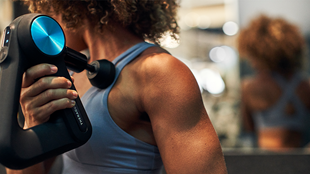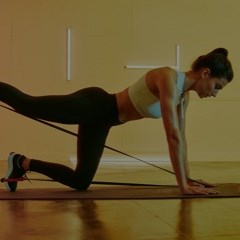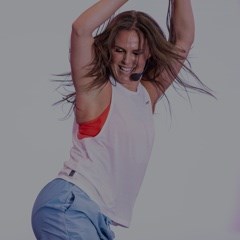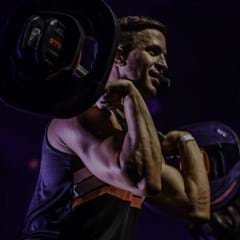You foam roll before class. You dedicate two days off a week as rest days and you diligently stretch and take regular Epsom salts baths. You try to get enough sleep and space out the time between classes, but somehow you still end up walking into the studio with aching muscles and wishing there was a magic pill you could take that would just make your body feel… normal.
Sound familiar?
We Instructors put our bodies through A LOT. And, unlike our participants, we don't have the luxury of taking rest days when we feel like it or not turning up to that class because we feel "a little bit tired". The show must go on and our recovery is very much dictated by our class schedule. So how do we help our bodies to perform on those days where we really just want to stay in bed? Enter percussive therapy.
WHAT IS PERCUSSIVE THERAPY?
Essentially, it's pressure plus vibration. Known as massage guns, percussive therapy devices look like small drills and they work by exerting bursts of repetitive pressure on the muscles to increase blood flow and release areas of tension.
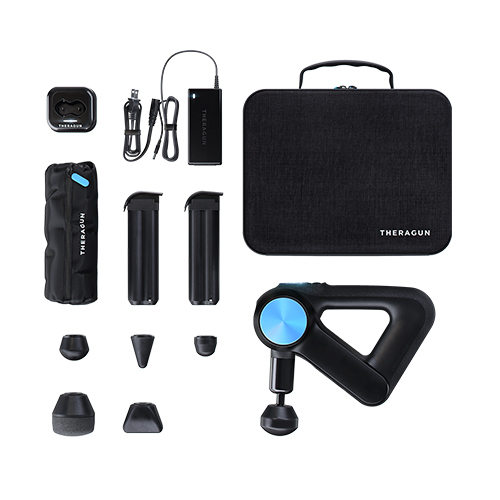
WHAT ARE THE BENEFITS?
Percussive Therapy causes the areas you treat to experience both vibration and pressure, the benefits of which are known to be:
- Improved health and function of soft tissues2
- Used pre-exercise it can reduce the delayed onset muscle soreness (DOMS) experienced post-exercise1, 8 and decrease the sensitivity to DOMS once you have it8, 11
- Reductions in muscle tension and potentiation of reflexes through mechanoreceptor stimulation2,3,4,7
- Decreases in acute pain and chronic pain6,9
- Increased blood flow and muscle oxygen delivery5,10
- Improved relaxation and decreased anxiety12
Basically, it can be used pre-class to energize the body and soothe any aches and pains, and after class to aid recovery before your next session.
HOW DOES IT DELIVER THESE BENEFITS?
The pressure exerted on the muscle works to improve tissue relaxation and decrease pain sensitivity – this occurs through the stimulation of receptors found in muscle, ligament and tendinous tissues. Think massage or foam rolling.
This is then combined with vibration. Similar to the effect of pressure, vibration increases blood flow and tissue oxygenation. Using vibration pre-exercise can also provide a protective effect by reducing swelling and decreasing the pain associated with DOMS experienced post exercise.
The combined effect of the pressure with the vibration produces the effect known as percussive therapy.
I ALREADY STRETCH AND FOAM ROLL. DO I ALSO NEED A MASSAGE GUN?
"It's going to enhance what you're already doing," Chiropractor Dr Jason Wersland, the pioneer of Theragun Percussive Therapy and the man behind Theragun, told Runners World. "For example, as well as a recovery tool after a session it's also extremely effective as part of your warm-up too. It gives you your expected outcome in less time with less discomfort. If you apply a massage gun to the muscles you want to stretch and then stretch them you can increase the improvement in range of motion 50-80% in 30 seconds, according to our research. The idea is that your stretching will be more effective, it won't take as long, it will happen deeper in the tissues, and it gives you a larger range of motion."
One of the additional benefits of massage guns – when compared to the size of foam rollers - is that the design allows them to zone in on a specific area of discomfort and target where your body needs it the most.
WHAT'S THE RESEARCH?
There are several studies out there that point to the benefits of percussive therapy. A 2014 study indicated that vibration therapy and massage are equally effective methods to prevent DOMS - meaning you’re less likely to feel muscle pain or tightness 24 to 72 hours after an intense workout. Whilst the science of Percussive Therapy is built on the evidence from both the application of pressure and local vibration, Therabody, as the industry leader of Percussive Therapy also has 20+ ongoing studies across 7 academic institutions. As this research emerges it will help further optimize how both you and your participants use Percussive Therapy to help achieve their goals.
WHO LOVES IT?
Creative Director and BODYSTEP Program Director Mark Nu’u-Steele is a massive fan of his Theragun!
"I'm addicted to being pain free, and daily percussive therapy with my Theragun is my tool of choice," says Mark. "I use it before teaching classes and weight training to warm-up and activate my muscles and post workout for recovery. I also use it before bed to aid with my sleep patterns and ultimately, to wake up ache free.
For the inexperienced, the latest generation of Theragun connects via Bluetooth to a phone app, and guides you through various sessions, depending on what your body needs. I'm at a stage now where I consider myself a Theragun Ninja! I use all the different grips, attachments and angles to get a full body treatment. For me, massages from a human are a thing of the past. My whole family are now serial Theragunners!"
For more information, check out Therabody's website and learn more about their products here.
REFERENCES
- Bakhtiary, A. H., Safavi-Farokhi, Z., & Aminian-Far, A. (2007). Influence of vibration on delayed onset of muscle soreness following eccentric exercise. British journal of sports medicine , 41 (3), 145-148.
- Behm, D. G., & Wilke, J. (2019). Do Self-Myofascial Release Devices Release Myofascia? Rolling Mechanisms: A Narrative Review. Sports Med .
- Cavanaugh, M. T., Doweling, A., Young, J. D., Quigley, P. J., Hodgson, D. D., Whitten, J. H., . . .Behm, D. G. (2017). An acute session of roller massage prolongs voluntary torque development and diminishes evoked pain. Eur J Appl Physiol, 117 (1), 109-117.
- Cochrane, D. J. (2011). The potential neural mechanisms of acute indirect vibration. Journal of sports science & medicine , 10 (1), 19.
- Egan, C. E., Espie, B. H., McGrann, S., McKenna, K. M., & Allen, J. A. (1996). Acute effects of vibration on peripheral blood flow in healthy subjects. Occupational and environmental medicine , 53 (10), 663-669.
- Hollins, M., McDermott, K., & Harper, D. (2014). How does vibration reduce pain?. Perception , 43 (1), 70-84.
- Issurin, V. B. (2005). Vibrations and their applications in sport. A review J Sports Med Phys Fitness , 45 (3), 324-36.
- Lu, X., Wang, Y., Lu, J., You, Y., Zhang, L., Zhu, D., & Yao, F. (2019). Does vibration benefit delayed-onset muscle soreness?: a meta-analysis and systematic review. Journal of International Medical Research , 47 (1), 3-18.
- Lundeberg, T. (1984). Long-term results of vibratory stimulation as a pain relieving measure for chronic pain. Pain , 20 (1), 13-23.
- Macaulay, T.R., Ramirez, J.E., Choi, J., Jones, M., Schroeder, E.T. (2019). Blood flow response and changes in fluid distributions after percussive massage therapy. Medicine and Science in Sports and Exercise . S226 Vol. 49 No. 5 Supplement.
- Sahebazamani, M., & Mohammadi, H. (2012). Influence of vibration on some of functional markers of delayed onset muscle soreness. International Journal of Applied Exercise Physiology , 1 (2).
- Weerapong, P., Hume, P. A., & Kolt, G. S. (2005). The mechanisms of massage and effects on performance, muscle recovery and injury prevention. Sports medicine , 35 (3), 235-256.



